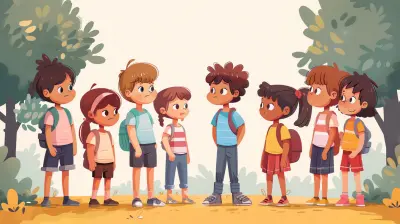Empowering Educators: Innovative Approaches to Teacher Training
13 June 2025
Teacher training has come a long way from chalkboards and notepads. With technology, changing student needs, and evolving education standards, today's educators require more than just textbook knowledge—they need adaptable, hands-on, and progressive training. And let’s face it—teachers are the heart of education. When we support and empower them, everything else falls into place.
So, how do we give educators the tools they need? How can we make teacher training not only effective but also exciting and relevant?
Let’s dive into the world of innovative teacher training and see how it's transforming classrooms, one educator at a time.
Why Traditional Teacher Training Isn’t Enough Anymore
If you’re a teacher reading this, you probably know what I mean. Long seminars. PowerPoint overload. Tons of theory, barely any practice.The traditional “sit-and-listen” models often miss the mark. They're outdated in many ways—they focus more on what teachers should know rather than showing how to apply that knowledge in real-life classrooms.
And here’s the kicker: students are changing. With digital tools at their fingertips, their learning styles have evolved. They're fast, curious, and easily distracted. So, if we want our teachers to keep up and keep students engaged, their training needs a serious upgrade.
The Shift Toward Empowerment in Teacher Training
The focus now is on empowering educators, not just informing them. We're moving from old-school lectures to interactive, collaborative, and personalized learning experiences.Instead of just teaching methods, modern teacher training programs help educators build resilience, foster creativity, and embrace continuous learning.
But what does “empowerment” really mean in this context?
It means giving teachers:
- Autonomy in trying new strategies
- Access to current technologies
- Ongoing support, not just during certification
- A voice in shaping both their training and curriculum
- Opportunities to grow professionally and personally
Let’s break down some of the most exciting innovative approaches making waves right now.
1. Microlearning: Training in Bite-Sized Pieces
We live in a world of short attention spans, and honestly, who has the time to sit through hours of training videos or endless reading materials?Enter microlearning—training delivered in short, focused segments. These could be 5-minute videos, quick quizzes, or digital flashcards that cover one topic at a time.
It's like snacking on knowledge instead of sitting down for a full-course meal. Microlearning is not only more digestible but also highly effective, especially for busy teachers juggling lesson planning, grading, and teaching.
Perks of microlearning:
- Flexible and accessible anytime, anywhere
- Promotes retention and immediate application
- Perfect for just-in-time learning
2. Peer-to-Peer Learning: Because Teachers Learn Best from Each Other
Let’s get real: some of the best teaching tricks come not from books but from other teachers. Peer-to-peer learning taps into this powerful idea.Whether through mentorship programs, teaching communities online, or school-level Professional Learning Communities (PLCs), this method encourages educators to support and learn from one another.
Think of it as a classroom for teachers—collaborative, enriching, and often the source of real-life solutions to everyday classroom challenges.
Why it works:
- Teachers feel more understood and supported
- Promotes reflective teaching practices
- Builds a sense of belonging and trust
And bonus: it fosters a culture of continuous improvement.
3. Personalized Learning Paths: No One-Size-Fits-All
Every teacher is unique. Some are tech wizards, others creative storytellers. Some love structure; others thrive on spontaneity.So why force them all through the same training modules?
Innovative teacher training embraces personalized learning paths, allowing educators to choose their pace, format, and focus based on their interests and gaps.
For example, a math teacher can dive deep into AI-assisted learning tools, while an English teacher might explore trauma-informed teaching strategies.
Benefits:
- Keeps learners engaged
- Respects their individual learning styles
- Encourages ownership of professional growth
It’s like giving teachers a GPS for their development journey—flexible, goal-oriented, and self-driven.
4. Gamification: Making Learning Fun Again
Who says training can’t be fun?Gamification involves adding game-like elements—points, badges, leaderboards, challenges—into training programs. It’s a sneaky but effective way to boost engagement and motivation.
Let’s be honest—everyone likes a little competition and reward, right?
When teachers rack up points for completing modules or solve real-life classroom challenges to earn badges, it turns professional development into an exciting quest rather than a chore.
Game-changing effects (pun intended):
- Increases participation
- Makes information stick better
- Sparks curiosity and playfulness in learning
5. Real-Time Classroom Simulations
Reading about classroom management is one thing—stepping into a chaotic class of 30 kids is another story.That’s where virtual simulations come in. These immersive tools let educators practice responses to real-world classroom scenarios in a risk-free environment.
It’s like a flight simulator—but for teachers.
Virtual simulations can mimic everything from misbehavior to tech failures, enabling teachers to test strategies, get feedback, and refine their approach.
Why it’s awesome:
- Safe space for trial and error
- Builds confidence
- Prepares teachers for unpredictable real-life situations
6. Mindfulness and Emotional Intelligence Training
Let’s face it, teaching can be emotionally exhausting. Managing a classroom, meeting standards, handling parents—it’s a lot.That’s why emotional intelligence (EQ) and mindfulness training are critical in modern teacher development.
Helping educators build self-awareness, regulate stress, and create emotional balance doesn’t just benefit them—it directly improves student experiences too. A calm, empathetic teacher creates a safe and supportive learning environment.
What’s in it for teachers:
- Better stress management
- Improved communication skills
- Stronger relationships with students
You can’t pour from an empty cup. This approach ensures that teachers are emotionally well-equipped to inspire and guide.
7. Tech Integration: Training That Mirrors Modern Classrooms
Technology is no longer a supplementary tool—it’s a core part of education. But giving teachers tech tools without training is like handing someone a piano and expecting them to play Beethoven.That’s why training has to reflect the tech-driven nature of today’s classrooms. From Google Classroom and Kahoot! to AI tutors and digital portfolios—teachers need hands-on experiences with educational technology.
Some programs even use AR/VR (Augmented and Virtual Reality) to prepare teachers for diverse classroom setups and learning challenges.
Why this matters:
- Teachers gain confidence using digital tools
- They stay ahead of technological changes
- They can integrate digital learning meaningfully
8. Ongoing, Rather Than One-Off, Professional Development
One workshop a year? Not enough.Teacher training should be continuous, not just a box to check.
Whether it’s monthly webinars, a yearly conference, or ongoing coaching, consistent professional development keeps educators sharp and inspired.
Modern initiatives also emphasize feedback loops, where teachers reflect on what’s working and what’s not, and receive guidance along the way.
Key advantages:
- Encourages lifelong learning
- Promotes adaptability
- Builds a growth mindset
After all, students aren’t the only ones learning every day!
Creating a Culture of Support: The Role of School Leadership
Let’s not forget that empowering educators isn’t just about training programs—it's also about the environment they're placed in.Strong leadership that values innovation, collaboration, and well-being makes a huge difference. When school leaders prioritize professional development and give teachers the freedom to implement new ideas, magic happens.
In a supportive school culture:
- Teachers feel trusted and valued
- They’re more willing to take risks and innovate
- Retention rates improve significantly
It’s a ripple effect—a happy teacher creates a happy classroom.
Final Thoughts: The Future Is in Our Educators' Hands
Training teachers isn’t just about checking off skills—it’s about fueling passion, cultivating innovation, and reigniting purpose.When we empower educators, we empower future generations. Innovative training isn't just a trend—it's the foundation of meaningful, modern education.
If you're a teacher, know this: your growth matters. If you're a school leader, make space for it. And if you're a policymaker, invest in it.
Because when teachers thrive, everyone wins.
all images in this post were generated using AI tools
Category:
Teacher TrainingAuthor:

Anita Harmon
Discussion
rate this article
2 comments
Clementine McDowney
This article highlights transformative strategies in teacher training, emphasizing hands-on experiences, collaboration, and technology integration to foster educator empowerment and enhance student learning outcomes.
June 22, 2025 at 4:49 AM

Anita Harmon
Thank you for your insightful comment! I'm glad you found the strategies of hands-on experiences, collaboration, and technology integration impactful in empowering educators.
Clarissa McElveen
Thank you for sharing this insightful article on innovative teacher training! It's inspiring to see such creative approaches that empower educators. By embracing new methodologies, we can enhance learning experiences for both teachers and students alike. Looking forward to seeing more discussions on this vital topic in the future!
June 19, 2025 at 3:42 AM

Anita Harmon
Thank you for your thoughtful feedback! I’m glad you found the article inspiring. Let’s continue the conversation on these vital approaches!


